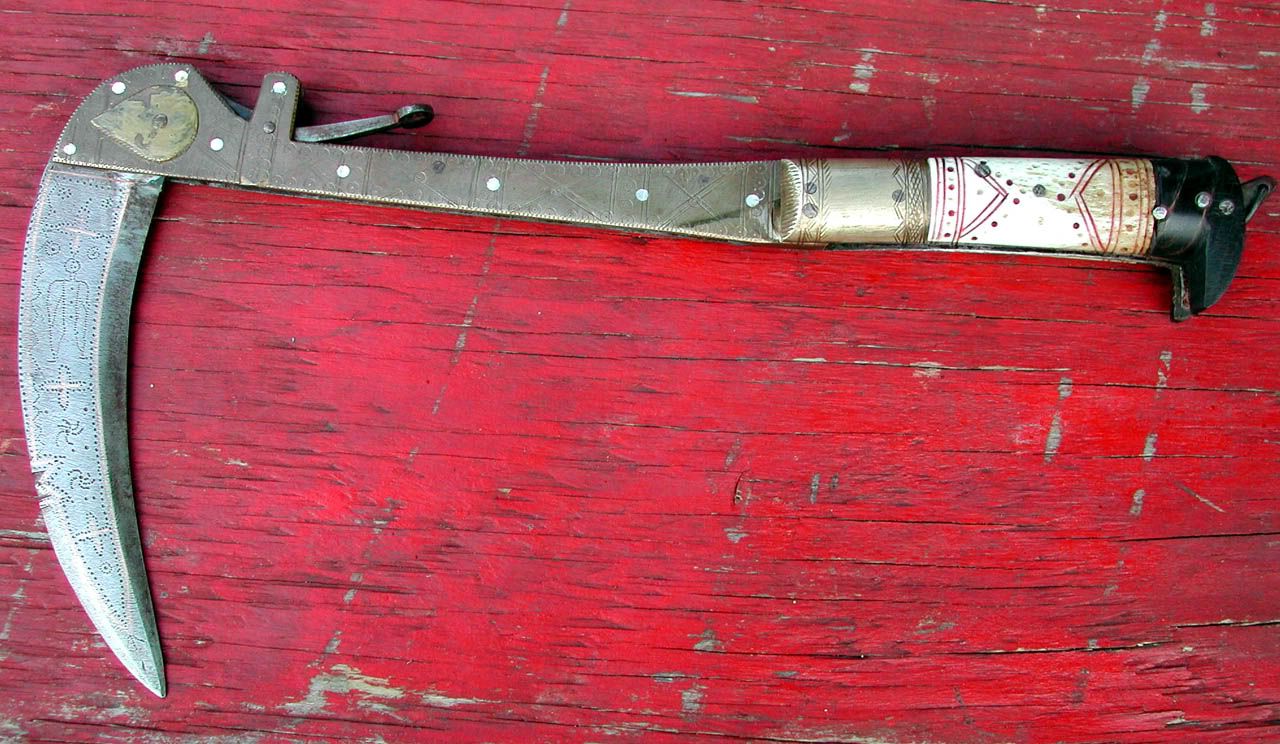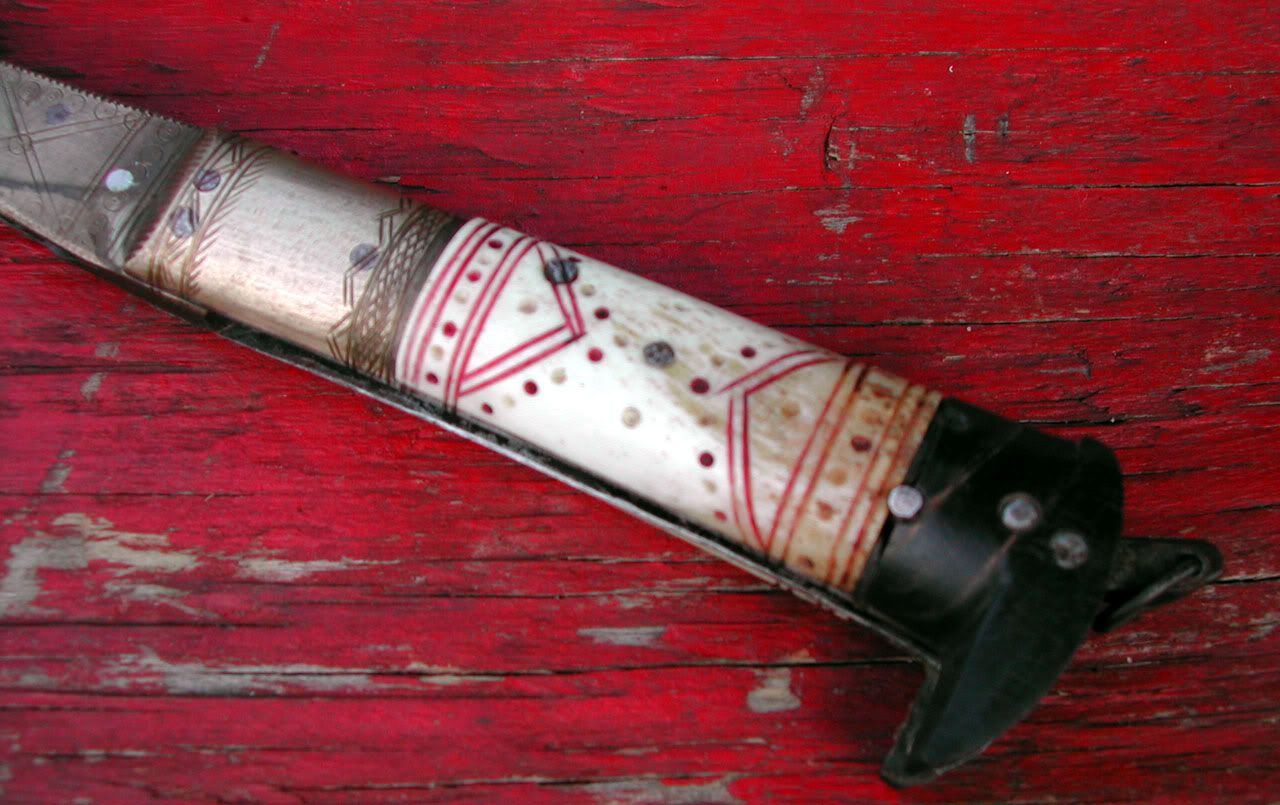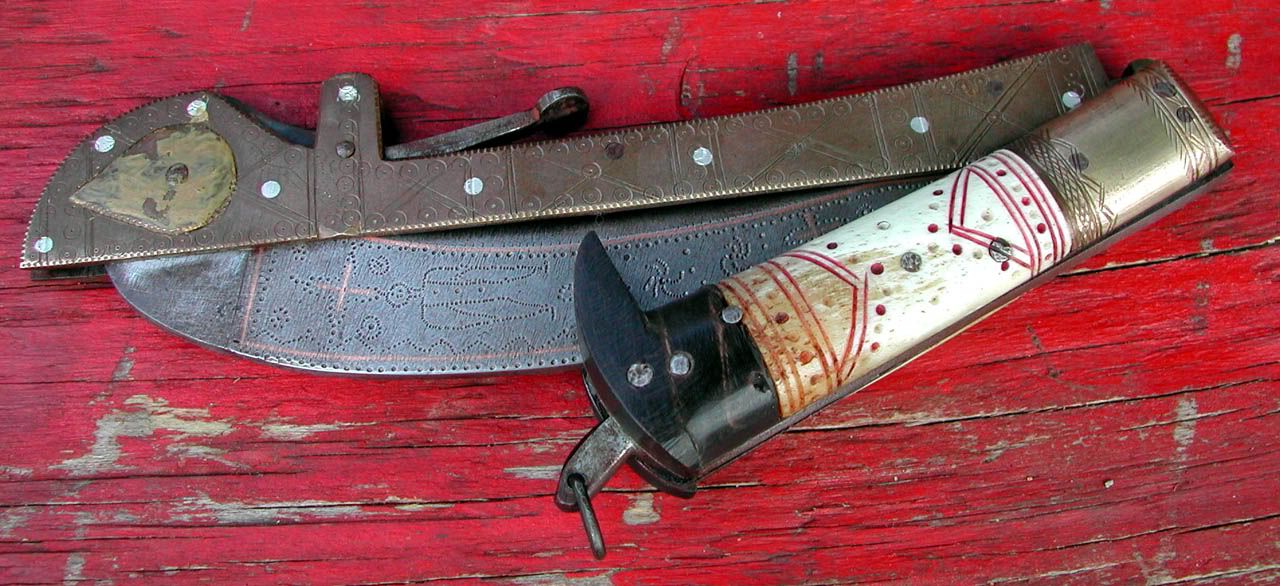
 |
|
|
#1 |
|
Member
Join Date: Mar 2005
Location: USA Georgia
Posts: 1,599
|
I believe this is from the Banochi Afghan tribe from the Khyber pass area. An "up close and personal" fighting pick (or perhaps as an earlier thread proposed, for ice or candy
 ) Anyhoo 11.60" open with a 5.4" curved locking blade. All folds up into the bone handle to a discreet carrying size of about 8". ) Anyhoo 11.60" open with a 5.4" curved locking blade. All folds up into the bone handle to a discreet carrying size of about 8".Each man in the tribe makes and embellishes his own LOHAR, and each individual has his own patterns which differs from those used by others; they all have basic similar shape: A short and light axe/pick/knife blade mounted on a somewhat short handle This is also the first one I have ever seen with a scabbard/shoulder holster. I always wondered how they were carried. A dangerous and effective weapon in an experienced hand. I have seen others of these and this seems to be one of the better constructed and decorated folders. Your comments? In the "Shoulder Holster"  Still Folded  Hilt unfolded  Blade unfolded and ready for action!  Closeup of handle. Projection should keep it from slipping during use.  Blade is wicked sharp 
Last edited by Bill Marsh; 5th January 2008 at 11:15 PM. Reason: spelling |
|
|

|
|
|
#2 |
|
Member
Join Date: Dec 2006
Location: Idaho, USA
Posts: 228
|
Nice one. I have a very similar one, but no shoulder holster. This is not for chipping ice or candy. These were also very popular with the "Afghan Navy".
Cheers bbjw |
|
|

|
|
|
#3 |
|
Member
Join Date: Oct 2007
Posts: 2,818
|
Hi Bill,
Nice item you have there, I have seen many over my years of collecting but never went out on limb to buy one even though I am always fasinated by weapons of the unusual. I have seen an identical pair before and as these folding "axes" resemble the japanese martial arts weapon the kama, I wonder if fighting styles are similar too. Apart from protection, do you think they have anyother use? Having never held one, would be suitable to hold a mans weight if he was to use these as an aid to climbing mountain regions, just to get that little extra reach if needed? All ways a pleasure to view item of your collections. best regards Gavin Australia |
|
|

|
|
|
#4 |
|
Member
Join Date: Dec 2006
Location: Idaho, USA
Posts: 228
|
Gavin- I have a non folding one as well and it would support a man's weight, but I'm sure that was not the intended purpose.
Cheers bbjw |
|
|

|
|
|
#5 |
|
Member
Join Date: Mar 2005
Location: USA Georgia
Posts: 1,599
|
Anyone have any history on these?
All I know is that the seller called mine "antique." |
|
|

|
|
|
#6 | |
|
Arms Historian
Join Date: Dec 2004
Location: Route 66
Posts: 9,952
|
Quote:

|
|
|
|

|
|
|
#7 |
|
Member
Join Date: Dec 2004
Location: Kernersville, NC, USA
Posts: 793
|
Hi Bill,
I have one and love it. I'd love to have one of the fixed type. I always suspected that the folding ones were made to sell to westerners. Don't have a bit of evidence of that, just a feeling. But it would be a formidable weapon.  Steve    
|
|
|

|
|
|
#8 |
|
Member
Join Date: Dec 2004
Location: What is still UK
Posts: 5,807
|
That looks rather like a holster for a small pistol. I am still of the nomad camp kitchen equipment opinion. A folded weapon in a quick draw holster seems rather a contradiction unless you throw it unopened at your enemy. Perhaps the holster came from an Afghan Navy Colt.
 These interpretations of objects are bound to happen. I and many others have a food masher sold as a club which would also make an effective weapon. In a previous thread about these the kitchen object seemed to be confirmed by the horses mouth so to speak. |
|
|

|
|
|
#9 |
|
Arms Historian
Join Date: Dec 2004
Location: Route 66
Posts: 9,952
|
As Tim has noted, the interpolation of implement or tool and weapon has existed from time immemorial, and each has found use as the other in countless examples.
I'm really glad that Bill has posted this interesting example of the elusive item termed the 'lohar'. Over many years, as many discussions have failed to make any determinations on the history or actual use of these unusual pickaxe type items. The only real reference to them is the now venerable chestnut from Stone: "LOHAR: A small pick used in the place of a sword by the Banochie, a Khyber tribe. Each man makes his own and decorates the handle with inlays of silver and brass. Each individual has his own patterns which differ from those used by others, though all are similar". (pp.418-19) Actually the term 'Banochie' refers to the Bannuchi, a tribe who were among earliest inhabitants of the Bannu District now part of Pakistan in Northwest Frontier province. These regions, as most will probably agree, reflect intense geopolitical and tribal flux that has continued for more than centuries, and the term Bannuchi is broadly applied to many of the tribal people in these regions. Locally of course, ancestry is recognized more specifically and to descent from specific tribal progenitors. I believe that the early forms of these 'lohar' were small, fixed blade weapons that recall other hafted weapons such as the Indian zaghnal, which quite plausibly may have descended from early forms of Chinese dagger axe. These weapons of course were among the considerable elements of culture that diffused to the west along the Silk Road. The early Bannuchi were eventually a pastoral people, and inhabited regions near Kurram and Tochi rivers, and with this of course suggesting use of implements that might be of this form. As is often the case, and as previously noted, weapons are often designed from tools or agricultural implements, as thier effectiveness in form is typically established by thier opportune use for both. Perhaps, the weapon form of such an implement might have been fashioned to be used as a weapon, and with the emphasis on the geometric symbolism, there may have been a ceremonial application as well. The term lohar has often come to mind as well, and actually comes from a Hindi term for iron, as this group of people are itinerant blacksmiths of these regions. It would seem quite possible that these smiths, who are known for repairing and making agricultural implements, may well have been the source for the 'lohar' term in these small pickaxe form weapons. To me, it would seem unlikely that all individuals of a tribe or group would have the tools, skills or means of fashioning and decorating these items as suggested by Stone. They might however, commission such axes to be made by the Lohar, and as commonly seen, the term became vernacular for the weapon. As for the use of these axes, I would suggest that they may well have been used as weapons in the 19th century, and as Stone has noted, in lieu of the sword. Ordinary tribesmen typically had no means for owning such weapons as swords, and since they could not easily conceal them, nor the skills in swordsmanship, they probably preferred a weapon they were comfortable and confident in using. The shape of this bladed axe would lend itself well to the penetration of the thick folds of the turban, as well as the grim thought of hamstringing of either mounted horsemen or thier horses. I do not think these were a widely used weapon form, as they obviously are not represented in armouries, nor have they been noted in the narratives as far as I know. The more modern examples of the lohar, which seem consistantly to be of the folding form as seen here, are as noted in previous discussions, unlikely for use as weapons. As always, surely they could be used as such, but seem intended more for utility. The motif seen on these seem to typically carry certain geometrics, particularly the circled dot, well known on ivory or bone grips of weapons in many Central Asian regions, especially Afghanistan. It seems this simple form is of course well known in other spheres as well, but not quite as consistantly as the Afghan and NW Frontier regions. The repeated 'X's and the + are motifs that represent typically the four cardinal directions, and the combinations of these and other symbols and motif are more likely to represent either amuletic or other traditional meaning than applying to individuals. I hope that this review of my personal observations and opinions on these curious weapons will be of interest, and as always, I look forward to those of others. With all best regards, Jim |
|
|

|
|
|
#10 |
|
Member
Join Date: Dec 2006
Location: Idaho, USA
Posts: 228
|
Some photos of my lohars. I wish my fixed blade one was in better cond., but it is very old and I was lucky to find it.
bbjw |
|
|

|
|
|
#11 |
|
Member
Join Date: Mar 2005
Location: USA Georgia
Posts: 1,599
|
My fixed blade lohar. Had it a while.
|
|
|

|
|
|
#12 |
|
Arms Historian
Join Date: Dec 2004
Location: Route 66
Posts: 9,952
|
Now THAT is a lohar Bill!!!
What a beauty, and fascinating markings. Are those dots brass, gold or red? Not drawing any particular association, but concerning the 'thuggee' pickaxes I brought up on another thread, they typically were marked with seven red dots. Since nobody I know of has ever seen a thuggee axe, for some reason I used to think these might have been something like them. All the best, Jim |
|
|

|
|
|
#13 | |
|
Arms Historian
Join Date: Dec 2004
Location: Route 66
Posts: 9,952
|
Quote:
I like seeing the contrast of the old fixed blade lohar next to the more modern folding blade example. It seems I read somewhere these started being made that way in about the 1920's, but since I cant cite, the reference is pretty much moot. They look kinda like an Afghan 'navaja' !!  BTW , good one on the holster from an Afghan Navy Colt Tim 
|
|
|
|

|
|
|
#14 |
|
Member
Join Date: Jan 2007
Posts: 181
|
Two comments on the functionality of these as weapons as opposed to work implements. One, some of the mountain tribes used hide or metal shields in combat; the lohar would be an effective way of hooking such a shield and pulling it aside to allow for a blow from one's primary weapon. As for the awkwardness or 'tourist' value of a folding version, a little experimentaion on my part proved that a well-maintained example would open quickly with the snap of the wrist, much like a gravity knife. A shoulder holster would provide a primitive version of a 'concealed carry' weapon.
|
|
|

|
|
|
#15 |
|
Member
Join Date: Dec 2004
Location: Athens Greece
Posts: 479
|
Nice lohars gentlemen.
I think that the holster comes from a karud. I had a similar one |
|
|

|
|
|
#16 |
|
Arms Historian
Join Date: Dec 2004
Location: Route 66
Posts: 9,952
|
This was really an interesting topic, and the lohar a quite unusual weapon (despite all the discussion on candy picks etc.).
On the fixed blade example posted by Bill, I just noticed there are red dots placed on the motif, though they seem indiscriminate in number. As I mentioned some time ago on another thread, and in this thread, the mysterious cult of the Thuggee used a small pickaxe with considerable ceremony in thier depradations. Although I have never found evidence of any of these Thuggee pickaxes ever having survived after the presumed suppression of the cult, the contemporary narratives occasionally mention that there were seven red dots strategically placed on the head of the axe. I wonder of the red dots on Bills lohar might have any connection ? It seems that red often appears highlighting symbolic motif on sacrificial weapons in India and Nepal, and I am wondering about that symbolism as well. Anyone have thoughts or observations on the red dots or use of red coloring on ceremonial weapons? |
|
|

|
|
|
#17 |
|
Member
Join Date: Mar 2006
Location: Room 101, Glos. UK
Posts: 4,184
|
sheath reminds me of a UK sword frog : one variant

|
|
|

|
 |
|
|